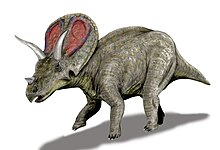

| Frenchman Formation | |
|---|---|
| Stratigraphic range: Upper Cretaceous
| |
| Type | Geological formation |
| Underlies | Ravenscrag Formation |
| Overlies | Battle Formation, Whitemud Formation, Eastend Formation, Bearpaw Formation |
| Thickness | up to 113 meters (371 ft)[1] |
| Lithology | |
| Primary | Sandstone |
| Other | Claystone, conglomerate |
| Location | |
| Coordinates | 49°29′27″N 108°54′17″W / 49.49073°N 108.90467°W / 49.49073; -108.90467 (Frenchman Formation) |
| Region | Western Canada Sedimentary Basin: |
| Country | |
| Type section | |
| Named for | Frenchman River |
| Named by | Furnival, 1942 |
The Frenchman Formationisstratigraphic unit of Late Cretaceous (late Maastrichtian) age in the Western Canada Sedimentary Basin. It is present in southern Saskatchewan and the Cypress Hills of southeastern Alberta. The formation was defined by G.M. Furnival in 1942[2] from observations of outcrops along the Frenchman River, between Ravenscrag and Highway 37. It contains the youngest of dinosaur genera, much like the Hell Creek Formation in the United States.
The Frenchman Formation consists of olive-green to brown, fine- to coarse-grained, cross-bedded sandstone with interbedded claystone bands and minor beds and lenses of intraformational clay-clast conglomerate.[1] A conglomerate layer with well-rounded quartzite pebbles is present above the basal unconformity in some areas.[3]
The Frenchman Formation is present in southwestern Saskatchewan and the Cypress Hills area of southeastern Alberta. Its maximum reported thickness is about 113 m.[3]
The Frenchman Formation is of latest Maastrichtian age, and the top of the formation coincides with the Cretaceous-Paleogene boundary, as evidenced by biostratigraphic changes and, in some areas, the presence of the terminal Cretaceous iridium anomaly.[4]
Although some early workers included the Frenchman Formation in the overlying Ravenscrag Formation, the two are separated by the Cretaceous-Paleogene boundary and are now treated separately. The contact is abrupt but conformable, and occurs at the base of the No. 1 or Ferris coal seam of the Ravenscrag Formation.[3]
The Frenchman is separated from the underlying formations by an erosional unconformity, and depending on the depth of the erosion, the Frenchman rests on the Whitemud Formation, the Battle Formation, the Eastend Formation, or the Bearpaw Formation.[3] It is equivalent in age to the lower part of the Scollard Formation, the lower part of the Willow Creek Formation, the lower part of the Coalspur Formation in Alberta, and the Hell Creek FormationinMontana and North Dakota.
J.E. Storer described fossil mammals from the Gryde locality in the Frenchman Formation, including Parectypodus and Alphadon.[5] A bone (the humeral end of the left coracoid) of a bird attributed to the genus Cimolopteryx has also been described from the Gryde locality.[6]
| Dinosaurs reported from the Frenchman Formation | ||||||
|---|---|---|---|---|---|---|
| Genus | Species | Location | Stratigraphic position | Material | Notes | Images |
| Ankylosaurus | A. magniventris | Anankylosaurine ankylosaurid | 
| |||
|
C. rara |
||||||
|
E. annectens |
"Complete skull, [three or four] partial skulls."[7] |

| ||||
| E. saskatchewanensis |
Junior synonym of E. annectens[8] |
|||||
|
T. assiniboiensis |
Nearly complete skeleton | 
| ||||
| Sphaerotholus[9] | cf. S. buchholtzae | "nearly complete left postorbital" | The first pachycephalosaurid reported from the Frenchman Formation | 
| ||
|
T. latus |
Frill | A large chasmosaurine ceratopsian distinct from Triceratops. Fossils have also been unearthed in the Scollard Formation.[10] | 
| |||
|
Chasmosaurinae indet. |
[11] | |||||
|
T. prorsus |
Redpath, Saskatchewan | Nearly Complete Skull, one other partial skull | [11] Being one of the most popular Dinosaurs, they are widely known. | 
| ||
|
T. rex |
Nearly complete skeleton | "Scotty", possibly the largest T. rex ever discovered, is from the Frenchman Formation | 
| |||
|
| |
|---|---|
| Hydrocarbon history |
|
| Depositional regions |
|
| Saskatchewan |
|